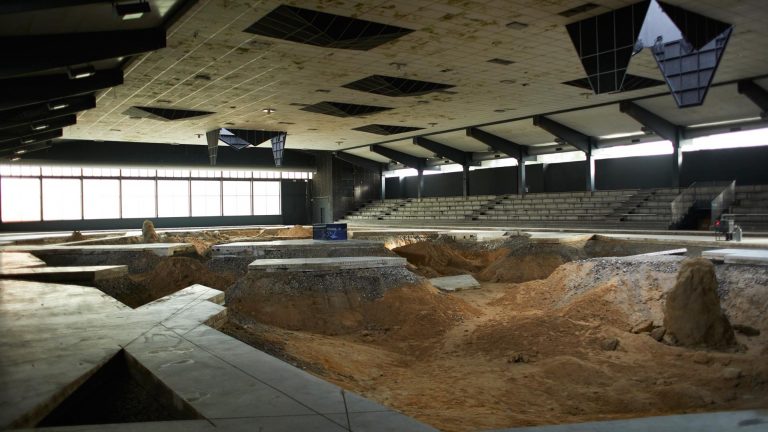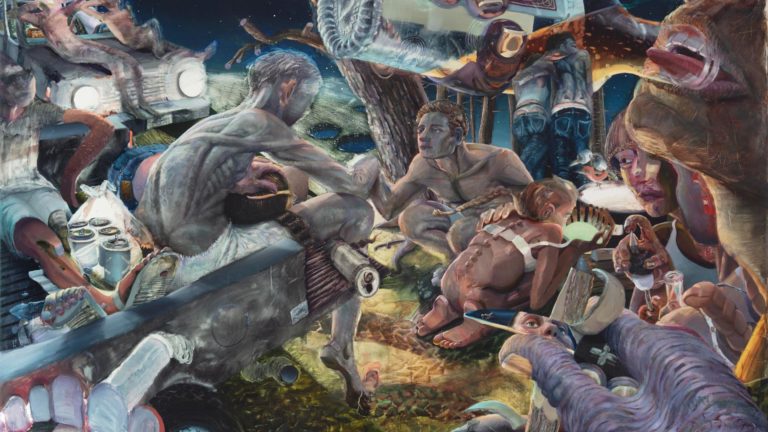Artist: Dala Nasser
Exhibition title: Red in Tooth
Venue: Kölnischer Kunstverein, Cologne, Germany
Date: May 14 – June 26, 2022
Photography: all images copyright and courtesy of the artist, Kölnischer Kunstverein and Deborah Schamoni
Kölnischer Kunstverein is pleased to present Dala Nasser’s first institutional solo exhibition Red in Tooth, featuring her multimedia installation of the same title. Comprising a video work, patchwork paintings, and a commissioned sound installation in collaboration with sound artist Mhamad Safa, Red in Tooth is the point of origination for her ongoing examination of decolonial ecologies and human and non-human entanglement. It’s a grounding proposal of how to listen, smell, see and sense what has been tuned down/out and made invisible by the ongoing practices of extraction and protracted colonial erasure.
Building on her practice as a material and process-based artist, through abstraction and alternative forms of image making, she cultivates a necessary discomfort through a renewed trust in the land, its rivers, and its more-than-human inhabitants. The works trace the Al Wazzani River, which flows through southern Lebanon into Occupied Palestine. Along this splintered journey, Nasser is forced to abandon state road infrastructures that are built to keep us in their lanes, and follow the soil and its color and smell, the burble of water, and other inhabitants of these lands; the animals; through vast wild ‘virgin’ terrains of southern Lebanon leading us to the border defying Wazzani. This frontier, which breeds life in its natural resources and wildlife is only partially accessible to a few families who live in the immediate area – and under difficult conditions. The trial to bear witness to ongoing slow violence, dispossession, and other colonial practices under constantly shifting, changing, and morphing conditions is (nearly) impossible. Nasser’s insistence to be guided by other environmental signifiers in her ongoing exercise to consider other possible social and political imaginaries, begs the question of how we listen to more-than-human ecological knowledges around us. How do we re-calibrate our relationship to the land and its wildlife and other beings, to find a way to listen to their unuttered testimonies? How can we learn from them to navigate the cracks of rigid colonial structures; both material and those of collective memory(s), history(s), and archives?
Reverting to a seemingly ritualistic intuition, the paintings have been dug into the earth around the Wazzani, washed with collected rainwater and/or boiled in salt water, they smell of the wretched soil and carry accumulated matter within it. They are imprinted with an-other memory, reality, and futurity; years of erosion, degradation, loss of water, pollution, and increased salinity imbued with a history of natural life, extraction, death, blood, violence, and land grabs. It’s an attempt to listen to the soil, its ailments and hopes, through that which has truly witnessed and continues to survive there. The large patchwork piece has been reassembled for the lecture hall (Riphahnsaal), the paintings are suspended and cascaded down from the stage to the center where they disharmoniously meet the accompanying site-specific sound installation. The sound work, a collaboration with sound artist and architect Mhamad Safa, manipulates the temporality of the environment through time-based effects. It brings our attention to the crackles of the field recordings from the river and its surrounding area, the birds, the crickets, the wind. The result is an immersive abstracted visual, sonic, and olfactory conditioning that urges us towards a slower, more focused reading and sensing.
In the second space, the video work negotiates and reveals other possibilities of being and relating through learning from the intricate nuances and complexities of the genuinely decolonial species, terrain, and wildlife of the area. Narrated by the wildlife as witnesses whose testimonies have no words, the film transitions between moving shots of a road most traveled, human produced waste, constructed borders, political signage, existing topographical markers animated as imaginary lines, the inhabitant’s voices, dead and living animals, and long, beautiful, desolate imagery of landscapes of southern Lebanon and northern Occupied Palestine. Through a studied use of imagery and sound, Nasser, at times, paints an impressionist-like painting that transports us to and from another possible way of life and lived reality.
The exhibition demands a multisensorial presence and engagement as colonial practices and landscape are abstracted within the spaces on a material, olfactory, sonic, and visual level. Red in Tooth is a reminder that we have made the wrong decisions, we have trusted the wrong materials, we have been listening to the testimonies of those who have not witnessed for too long. It reveals to us an entrapped power dynamic between colonial structures, people, animals, plants, the river, and the soil, and invites us through Nasser’s subtle but radical language of abstraction to consider different forms of mobility and relationship to the land.
-Reem Shadid
Dala Nasser: Red in Tooth, 2021. Single channel video, color with sound, 20 min. Kölnischer Kunstverein, 2022. Courtesy: the artist and Deborah Schamoni. Photo: Mareike Tocha
Dala Nasser: Red in Tooth, 2021. Single channel video, color with sound, 20 min. Kölnischer Kunstverein, 2022. Courtesy: the artist and Deborah Schamoni. Photo: Mareike Tocha
Dala Nasser: Red in Tooth, 2021. Single channel video, color with sound, 20 min. Kölnischer Kunstverein, 2022. Courtesy: the artist and Deborah Schamoni. Photo: Mareike Tocha
Dala Nasser: Red in Tooth, 2022. Installation view. Kölnischer Kunstverein, 2022. Courtesy: the artist and Deborah Schamoni. Photo: Mareike Tocha
Dala Nasser: Red in Tooth, 2020 – 2021 – 2022. Discarded fabric, buried underground for 2 weeks to 3 months, ash, charcoal, rainwater. Kölnischer Kunstverein, 2022. Courtesy: the artist and Deborah Schamoni. Photo: Mareike Tocha
Dala Nasser: Red in Tooth, 2022. Installation view. Kölnischer Kunstverein, 2022. Courtesy: the artist and Deborah Schamoni. Photo: Mareike Tocha
Dala Nasser: Red in Tooth, 2020 – 2021 – 2022 (detail). Discarded fabric, buried underground for 2 weeks to 3 months, ash, charcoal, rainwater. Kölnischer Kunstverein, 2022. Courtesy: the artist and Deborah Schamoni. Photo: Mareike Tocha
Dala Nasser: Red in Tooth, 2020 – 2021 – 2022 (detail). Discarded fabric, buried underground for 2 weeks to 3 months, ash, charcoal, rainwater. Kölnischer Kunstverein, 2022. Courtesy: the artist and Deborah Schamoni. Photo: Mareike Tocha
Dala Nasser: Red in Tooth, 2020 – 2021 – 2022 (detail). Discarded fabric, buried underground for 2 weeks to 3 months, ash, charcoal, rainwater. Kölnischer Kunstverein, 2022. Courtesy: the artist and Deborah Schamoni. Photo: Mareike Tocha
Dala Nasser: Red in Tooth, 2020 – 2021 – 2022. Discarded fabric, buried underground for 2 weeks to 3 months, ash, charcoal, rainwater. Kölnischer Kunstverein, 2022. Courtesy: the artist and Deborah Schamoni. Photo: Mareike Tocha
Dala Nasser: Red in Tooth, 2020 – 2021 – 2022 (detail). Discarded fabric, buried underground for 2 weeks to 3 months, ash, charcoal, rainwater. Kölnischer Kunstverein, 2022. Courtesy: the artist and Deborah Schamoni. Photo: Mareike Tocha
Dala Nasser: Red in Tooth, 2020 – 2021 – 2022 (detail). Discarded fabric, buried underground for 2 weeks to 3 months, ash, charcoal, rainwater. Kölnischer Kunstverein, 2022. Courtesy: the artist and Deborah Schamoni. Photo: Mareike Tocha
Dala Nasser: Red in Tooth, 2020 – 2021 – 2022 (detail). Discarded fabric, buried underground for 2 weeks to 3 months, ash, charcoal, rainwater. Kölnischer Kunstverein, 2022. Courtesy: the artist and Deborah Schamoni. Photo: Mareike Tocha
Dala Nasser: Red in Tooth, 2020 – 2021 – 2022. Muslin, salt, natural pigment. Kölnischer Kunstverein, 2022. Courtesy: the artist and Deborah Schamoni. Photo: Mareike Tocha
Dala Nasser: Red in Tooth, 2020 – 2021 – 2022 (detail). Muslin, salt, natural pigment. Kölnischer Kunstverein, 2022. Courtesy: the artist and Deborah Schamoni. Photo: Mareike Tocha
Dala Nasser: Red in Tooth, 2020 – 2021 – 2022. Kölnischer Kunstverein, 2022. Muslin, salt, natural pigment. Courtesy: the artist and Deborah Schamoni. Photo: Mareike Tocha
Dala Nasser: Red in Tooth, 2020 – 2021 – 2022 (detail). Muslin, salt, natural pigment. Kölnischer Kunstverein, 2022. Courtesy: the artist and Deborah Schamoni. Photo: Mareike Tocha























